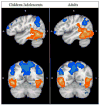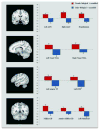Sex differences in the development of brain mechanisms for processing biological motion
- PMID: 23876243
- PMCID: PMC3815992
- DOI: 10.1016/j.neuroimage.2013.07.040
Sex differences in the development of brain mechanisms for processing biological motion
Abstract
Disorders related to social functioning including autism and schizophrenia differ drastically in incidence and severity between males and females. Little is known about the neural systems underlying these sex-linked differences in risk and resiliency. Using functional magnetic resonance imaging and a task involving the visual perception of point-light displays of coherent and scrambled biological motion, we discovered sex differences in the development of neural systems for basic social perception. In adults, we identified enhanced activity during coherent biological motion perception in females relative to males in a network of brain regions previously implicated in social perception including amygdala, medial temporal gyrus, and temporal pole. These sex differences were less pronounced in our sample of school-age youth. We hypothesize that the robust neural circuitry supporting social perception in females, which diverges from males beginning in childhood, may underlie sex differences in disorders related to social processing.
Keywords: Amygdala; Biological motion; Brain development; Sex differences; fMRI.
© 2013 Elsevier Inc. All rights reserved.
Figures




References
-
- Adolphs R, Spezio M. Role of the amygdala in processing visual social stimuli. Prog Brain Res. 2006;156:363–378. - PubMed
-
- Allison T, Puce A, McCarthy G. Social perception from visual cues: the role of the STS region. Trends Cogn Sci. 2000;4:267–278. - PubMed
-
- American Psychiatric Association. Diagnostic and statistical manual of mental disorders (DSM-IV) Washington, D.C: American Psychiatric Association; 1994.
-
- Armony JL, LeDoux JE. The Cognitive Neurosciences. Cambridge: MIT Press; 1999. How danger is encoded: Towards a systems, cellular, and computational understanding of cognitive-emotional interactions in fear circuits.
Publication types
MeSH terms
Grants and funding
LinkOut - more resources
Full Text Sources
Other Literature Sources
Molecular Biology Databases

